 Ace Your 2025 Bennett Mechanical Comprehension Test With Professional Practice
Ace Your 2025 Bennett Mechanical Comprehension Test With Professional Practice
The Bennett Mechanical Aptitude Test (BMCT) is one of the most popular mechanical aptitude tests but also one of the hardest to pass.
You have 55 questions to answer in 25 minutes, you need to understand the physical concepts behind them, and get a top 20% score to pass successfully.
Fortunately, JobTestPrep has created a full preparation for the Bennet Test with:
⦿ Tailored practice materials with full explanations that will make every question look easy.
⦿ Accurate simulation tests with the look and feel of the BMCT so you’ll be completely ready.
⦿ Bennet test guides and tips to handle the time pressure effortlessly.
On this page, you will get a small but powerful taste of our full test PrepPack™ and exhaustive study guides devised by our experts.
Hone your skills today with free Bennett Mechanical Comprehension Test practice and insider Tips & Tricks
- 2 Full BMCT-II Practice Tests
- Mechanical Study Guide and Electrical Comprehension Study Guide
- 21 more Mechanical Aptitude Practice Tests
- Explanations, solving tips, and score reports
- Exclusive to JobTestPrep
What is the Bennett Mechanical Comprehension Test (BMCT)?
The Bennett Mechanical Comprehension Test (BMCT) is an assessment developed by Pearson Assessments. The BMCT is used as a prerequisite during the employment process for many technical roles.
This test intends to seek out individuals with good mechanical reasoning abilities and includes questions covering your mechanical aptitude, spatial visualization, application of physics and ability to deduce how things work.
The original BMCT consists of 68 multiple-choice questions and has a 30-minute time limit. The updated BMCT II consists of 55 multiple-choice questions and has a 25-minute time limit. It is administered online only.
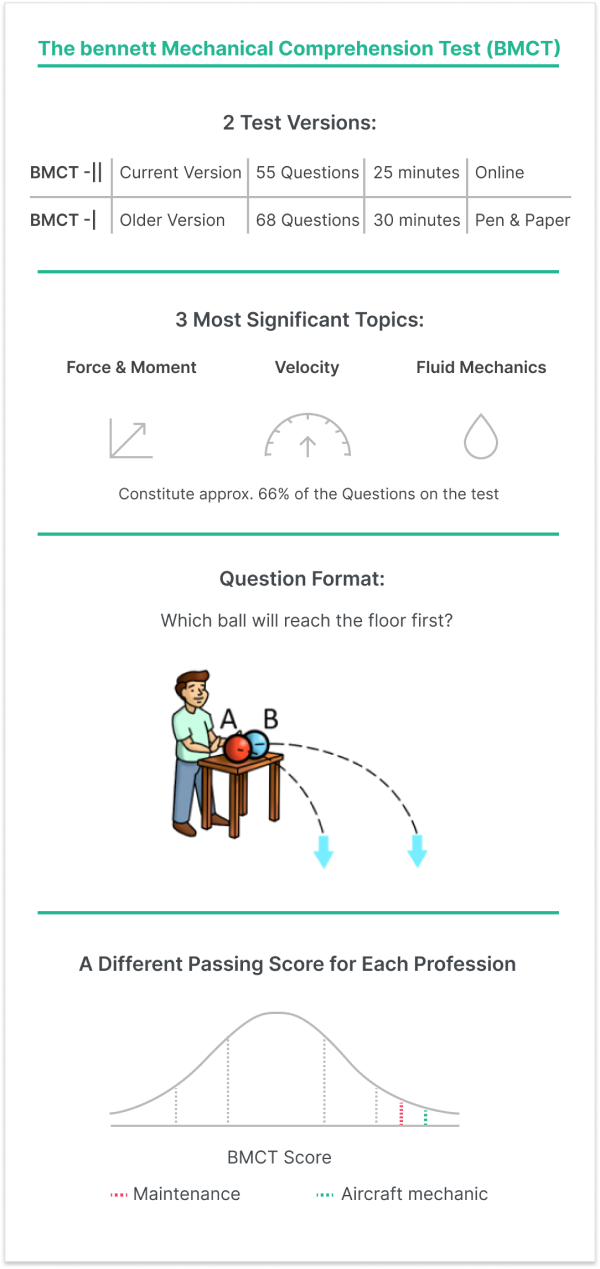
The BMCT, like many other psychometric tests, is administered under strict time constraints. The original BMCT consists of 68 multiple-choice questions that need to be answered in a 30-minute timeframe. The updated BMCT II, on the other hand, consists of 55 multiple-choice questions that will need to be answered in a 25-minute timeframe. The most common version of these tests that you will encounter during the recruitment process is the BMCT II.
The BMCT scoring process is based on item response theory (IRT). Since the questions on the BMCT are often randomly compiled through an item-banked system of 300+ questions, the IRT has been found to be the most ideal method of scoring.
This form of scoring can adapt to minor differences in difficulty between item-banked test versions so that scores are equivalent across organisations. Once you have completed the BMCT, the company will receive a comprehensive score report from Pearson. This report will represent your final score in a variety of ways; they are:
- Percentile Ranking
- Raw score (number answer correctly)
- T-score
- STANINE Score
- STEN Score
Your score can tell potential employers whether you are scoring in an appropriate range for your job level and if it will be beneficial for them to hire you. The higher that you score in any of these areas, the better your chances will be of landing the job you want.
The questions that you will encounter on the BMCT will be randomly generated from an item-banked system. This method allows for each BMCT test administered to be different in terms of questions, but equal in terms of question difficulty. As this is a mechanical exam, you will encounter many different types of questions regarding pulleys and levers, hydraulics, gravity and velocity, gears and belt drives, structures, planes and slopes, etc.
Watch the following video for an in-depth look into the BMCT:
What Does the Bennet Mechanical Aptitude Test Assess?
The BMCT assesses the following:
- Mechanical aptitude
- Spatial visualization
- Application of physics
- Deduction of "how things work"
The breakdown and frequency of the sections appearing on both the BMCT I and BMCT II can be found below:
On the BMCT I, there are 68 items split into 18 categories of mechanical principles:
| Category | Number of Items |
|---|---|
| Acoustics | 3 |
| Belt Drive | 2 |
| Center of Gravity | 7 |
| Centrifugal Force | 5 |
| Electricity | 6 |
| Gears | 10 |
| Gravity | 9 |
| Heat | 8 |
| Hydraulics | 16 |
| Inertia | 5 |
| Levers | 8 |
| Optics | 6 |
| Planes and Slopes | 2 |
| Pulley Systems | 10 |
| Resolution and Forces | 6 |
| Shape and Volume | 7 |
| Structures | 12 |
| Miscellaneous | 14 |
On the BMCT II, there are 55 items split into 12 categories of mechanical principles:
| Category | Number of Items |
|---|---|
| Pulleys and Levers | 7 |
| Hydraulics | 6 |
| Resolution of Forces, Centrifugal Force, and Inertia | 6 |
| Structures, Planes, and Slopes | 6 |
| Gears and Belt Drives | 5 |
| Miscellaneous | 6 |
| Gravity and Velocity | 4 |
| Acoustics and Optics | 3 |
| Center of Gravity | 3 |
| Electricity | 3 |
| Heat | 3 |
| Shape and Volume | 3 |
BMCT Sample Questions
Below you will find several BMCT sample questions with answers and answer explanations. Use the free test on this page to further gauge your mechanical aptitude skills for your upcoming exam.
BMCT Sample Question 1 - Velocity
The 101 of physics and the major topic on the BMCT. Acceleration, gravity, and Newton's laws are all common subjects in this section.
Which way is the wagon accelerating? (If either, mark C.)
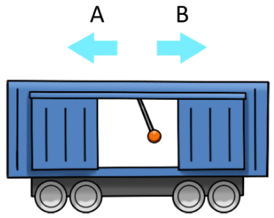
BMCT Sample Question 2 - Pulleys
With which pulley system would it be easier to lift the load? (If equal, mark C.)

Bennet Mechanical Test Content
Force and Moment
Your understanding of the principles of force and moment (torque) will be tested mainly via mechanisms, structures, and levers, as well as work-related scenarios such as carrying a hammer or tightening a screw.
★ Sample Question
In which direction should the acrobat move his body to balance the seesaw? (If neither, Mark C.)
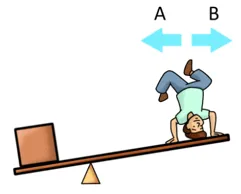
Fluid Mechanics
★ Sample Question
Here you will be asked about the main concepts of fluid like the ideal gas law, basic hydraulics, Bernoulli's principle, etc.
Which of the three following diagrams is correct?
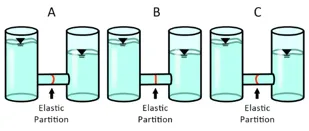
Thermodynamics
A big name for a fascinating subject – heating, cooling, condensation, and evaporation are discussed here. Next time you want to cool your beer fast, you'll know how to do it.
★ Sample Question
In which direction will the pressure gauge move if the closed oxygen canister is heated? (If either, mark C.)

Electricity
Here you will be asked about a completely different set of rules and principles. Most often, electricity questions here will deal with the fundamentals of electricity like Ohm's Law and DC electric circuits.
★ Sample Question
Which bulb will light up? (If both, Mark C.)
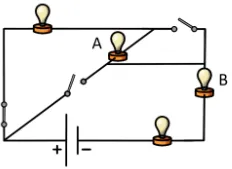
Wheels
In these questions, you will usually need to understand the relationship between wheel size and speed, rotational vs. linear velocity, etc.
★ Sample Question
Which part on the wheel will rotate faster? (If equal, Mark C.)
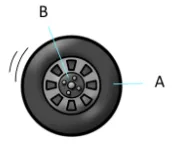
Gears
Although less common in the Bennett test than other mechanical tests, you can bet there will be at least some questions about gears. These will mainly test your understanding of gear ratio and the ability to deduce a gear's direction of rotation.
★ Sample Question
In which direction does the grey wheel turn? (If neither, mark C.)
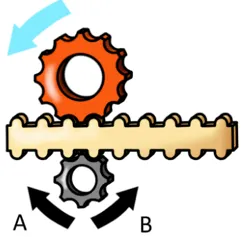
Pulleys
Mostly following the type (II) format, pulley questions will normally ask you to determine which of the two is more efficient.
★ Sample Question
Which pulley system requires more force to lift the box? (If equal, mark C.)
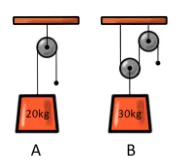
Acoustics
Some of the basic concepts of sound will be the centre of acoustics questions - the Doppler effect, refraction, reflection, and attenuation.
★ Sample Question
Which siren will sound higher-pitched to the man? (If equal, Mark C.)
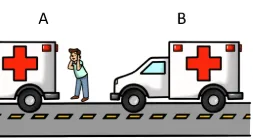
Optics
These questions deal with the basic concepts of light, reflection, and sight. Definitely a subject that requires a deeper understanding of the physics behind the scenes.
★ Sample Question
How will the man see his image in the mirror? (If neither, mark C.)
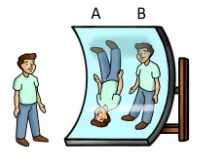
Bennett Mechanical Comprehension Test Preparation
Practise and get to know the physical principles behind each question:
Giving yourself time to practise for this or any exam will give you a good foundation for passing the test.
Knowing what to expect prior to test day will give you a clear advantage over other candidates and boost your chances of success when taking the Bennett Mechanical Comprehension Test
You will encounter a wide array of questions while taking the Bennett Mechanical Comprehension Test. Our specialised PrepPack™ includes questions stylised after those found on the Bennett test and include full answer explanations.
These answer explanations give detailed information on how to solve each problem you will be presented with as well as the mechanical principle associated with each question.
Knowing what to expect will improve your test-taking speed and accuracy, ultimately enabling you to obtain a high overall test score.
Free Bennet Sample Test
Get a feel for the real Bennett Mechanical Comprehension Test with this sample test that includes some of the most typical BMCT question types:
How to Understand Your BMCT II Test Results
Regardless of the different scores shown on your final BMCT score report the employer will receive, there will also be a percentile rating showing where your score falls compared to the normative group.
This percentile rating can tell the employer a lot about you in terms of your skills and if it will be beneficial to hire you. The higher your raw score is once you have completed the assessment, the higher your percentile rating will be.
This percentile placement can be interpreted as follows:
| BMCT-II Percentile Score Ranges | |
|---|---|
| 0 to 19 Range | This score tells the employer that it would be risky to hire you and that you may take longer to learn the job than someone scoring higher. This score also tells the employer that you may require closer supervision and that you may never reach the goals so out for you by the company. |
| 20 to 39 Range | This score shows the employer that you have a good grasp of mechanical and physical principles, however, you may still require close supervision while on the job. This score does give you the ability to still be considered for the role you have applied for only if you are able to demonstrate the desired interpersonal skills during the interview process. |
| 40 to 59 Range | This score demonstrates to the employer that you have a solid understanding of the necessary mechanical and physical concepts and are likely to learn the job being offered at a steady pace. Falling into this percentile range will have you dubbed as a ‘very good hire’ in the eyes of the recruitment team. |
| 60 to 79 Range | Falling into this percentile group shows the employer that you have an excellent grasp on the mechanical and physical concepts being tested. It also shows the employer that you will be able to learn your job quickly without too much need for close supervision. Scoring in this range will also have you dubbed as a ‘very good hire’. |
| 80+ Range | Falling into this percentile range shows the employer that you have a very strong, in-depth grasp of the mechanical and physical concepts being tested. Candidates who score in this percentile range will most likely learn the job quickly and will not need much if any supervision once it has been mastered. This scoring range also shows that you are a fast learner and are likely to pick up on unfamiliar concepts very quickly. |
Bennett Mechanical Comprehension FAQs
Individuals who work in the following industries may be required to take the BMCT:
- Engineer
- Automotive mechanic
- Equipment operators/transportation trades (truck driver)
- Automotive and aircraft mechanic
- Industrial/technical sales representative
- Installation/maintenance/repair
- Skilled tradesperson (welder, electrician, carpenter)
- Mechanical trades
Practising for the BMCT could be the difference between scoring below or above the average for your profession. According to Pearson, if you practise prior to this exam, you will be able to raise your score by 4 or more points. 4 points may not seem like much, however, this increase in points has the ability to show your employer whether you are scoring at the same level as a sales representative or at the level of an engineer. Increasing your BMCT score will help demonstrate your value to the company you have applied to.
Scoring high on the BMCT displays good spatial perception and mechanical reasoning ability. It also displays your knowledge of basic mechanical operations and physical laws, as well as an aptitude for learning mechanical processes and tasks. This, in turn, shows employers that you are a qualified candidate, thus heightening your chances of getting the job you applied for.
The BMCT is a timed test. On the BMCT II, you need to answer 55 questions in 25 minutes. By practicing for the test, you can improve your timing and answer accuracy during the exam.
Below you will find a list of employers who use the BMCT test in their recruitment processes:
Please note that while these companies may require you to take the Bennett Mechanical test, they may also require you to take additional assessments, participate in interviews, and/ or participate in group exercises.
| Company | Positions |
|---|---|
| Delta Airlines | Mechanic |
| Keyence | Sales/ Technical/ Engineer |
| BWXT | Supervisor/ Engineer/ Welder |
| Nestle | Electrician/ Maintenance/ Operator |
| Perry Technical Institute | Electrician & Technician |
| DuPont | Operator |
| Tyson | Maintenance |
| Culver Careers | Technician & Sales |
| Union Gas | Service Representative |
| Savant Sourcing | Quality inspector |
| Coca-Cola | Maintenance Mechanic |
| INEOS | Process Operator |
| Valero | Operator |



